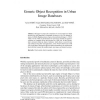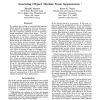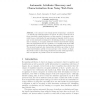112
click to vote
CCIA
2009
Springer
15 years 2 months ago
2009
Springer
In this paper we propose the construction of a visual content layer which describes the visual appearance of geographic locations in a city. We captured, by means of a Mobile Mappi...
130
click to vote
AAAI
1993
15 years 2 months ago
1993
We address the problem of automatically learning object models for recognition and pose estimation. In contrast to the traditional approach, we formulate the recognition problem a...
102
click to vote
WSCG
2004
15 years 2 months ago
2004
We present a real-time algorithm for rendering volumetric 3D Magic LensesTM having arbitrary convex shapes. During fragment processing the algorithm performs a second depth test u...
98
Voted
ATAL
2006
Springer
15 years 5 months ago
2006
Springer
In this paper, we present an architecture for software agents that enables them to learn vocabulary through the observation of each other bodies and actions. Besides sensors, effe...
117
click to vote
ECCV
2010
Springer
15 years 6 months ago
2010
Springer
It is common to use domain specific terminology – attributes – to describe the visual appearance of objects. In order to scale the use of these describable visual attributes t...
120
click to vote
ECCV
2002
Springer
16 years 3 months ago
2002
Springer
A visual representation of an object must meet at least three basic requirements. First, it must allow identification of the object in the presence of slight but unpredictable chan...
CVPR
2008
IEEE
16 years 3 months ago
2008
IEEE
Visual and non-visual data are often related through complex, indirect links, thus making the prediction of one from the other difficult. Examples include the partiallyunderstood ...



